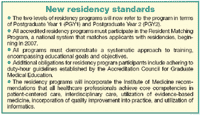ASHP sets up new standards for pharmacy residencies
Pharmacy residents can expect not only new standards in program requirements but also changes to the nomenclature of residencies. ASHP has approved the new standards for the accreditation of pharmacy residency programs at a time when the demand for postgraduate training programs is on the rise. The revised accreditation standards are scheduled to go into effect in January of 2007. They will replace the existing ASHP standards.
Pharmacy residents can expect not only new standards in program requirements but also changes to the nomenclature of residencies. ASHP has approved the new standards for the accreditation of pharmacy residency programs at a time when the demand for postgraduate training programs is on the rise. The revised accreditation standards are scheduled to go into effect in January of 2007. They will replace the existing ASHP standards.
The new standards will still allow the existing PGY1 (postgraduate year 1) programs to be in specific practice environments and patient populations, as long as the programs include a wide variety of disease states. PGY2 programs that provide a greater depth of knowledge may occur in these same environments and populations, but residents will be required to have completed a PGY1 program. The standards for managed care pharmacy practice residencies, as well as pharmacy practice residencies with emphasis in community care, remain unchanged. The new standards can be found at http://www.ashp.org/rtp/

Director of pharmacy services James Stevenson, Pharm.D, at the University of Michigan Hospital in Ann Arbor, said one important new change relates to duty-hour guidelines. "That mirrors what's done with medical residents where there are limitations on the number of hours they can work in a week. ASHP is asking that programs develop such standards. It's a patient safety concern." Also significant, noted Stevenson, is the new standard that incorporates some of the principles on interdisciplinary care and patient-centered care. "Those things weren't implicitly spelled out in the previous standards, so they're more clearly emphasized here."
Stevenson noted that using the matching program for second-year residency is also significant. "Typically, programs have been allowed to go out and recruit and make offers to their candidates on their own. That led to some problems, so ASHP has decided that extending the match to the second-year residencies is the way to resolve that."
The marketplace is driving the growth of postgraduate programs, noted Teeters. In the past, she commented, people used to differentiate themselves by either their residency or by going on to get a Pharm.D. Now, she said, "everybody has a Pharm.D., and it's the residencies and the fellowships that do the differentiating." She said ASHP is seeing a growth in the number of residency candidates as well as an upsurge in new programs. "The profession is changing and is becoming more clinical and more complex. On the hospital side, especially, they are looking for people with residency training."
According to Teeters, ambulatory care, managed care, and community care are among the residencies that are gaining in popularity. The biggest growth area continues to be PGY1 in pharmacy practice.